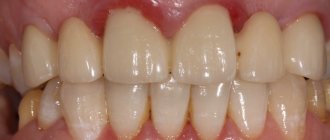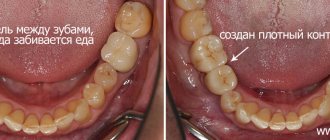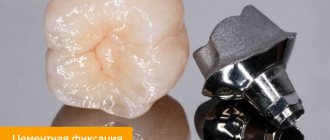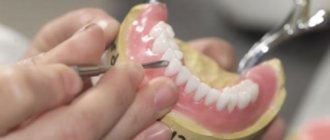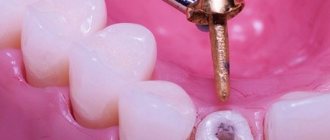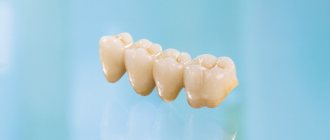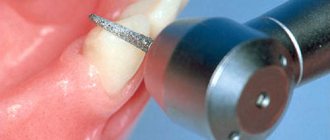- Service life of different types of crowns
- Late crown replacement
- When to change a crown
- How to change crowns
- How often are crowns replaced?
- Additional videos
Sooner or later, most people have to deal with dental prosthetics.
Perhaps the most common type of prosthetics is the so-called “dental crown” (more information about different crowns here). Many patients are their owners, but only a few patients ask questions: do dental crowns need to be replaced, how often should dental crowns be changed, etc.
Let's try to figure it out.
What is the service life of different types of crowns?
As you know, any structure has a certain service life. Unnecessarily long use can lead to dire consequences.
So: how often should crowns be replaced?
It is believed that the average service life of a crown is 5-7 years. At one time, scientists proved that it is after such a period of time that the cement on which the crown is fixed begins to undergo changes. But this does not mean that the crown must be changed every 5 or 7 years. During this period, a doctor should evaluate it to understand whether it can still serve or whether the crown needs to be replaced.
In addition to the duration of use, during a preventive examination, the doctor evaluates the following parameters: the quality of the marginal fit of the crown to the tooth, the condition of the gums and bone tissue next to the crown, X-ray data of the tooth, patient complaints, etc.
Features of fixing crowns on cement
Before starting the procedure, hardware diagnostics are prescribed. An X-ray image allows you to verify the correct integration and make the necessary corrections to the configuration before installing the crown. A prerequisite is the removal of excess dental cement, which can cause irritation of the mucous tissues adjacent to the area being restored.
Among the advantages characteristic of cementing are high structural stability, as well as the possibility of using passive fitting technology. Soft tissue support is provided by the abutment - the crown is installed so that its edge is located either at the same level or apical to the gum contour.
What determines the service life of a crown?
- The service life and the need to replace the structure greatly depend on the accuracy of manufacturing at all stages. Precision work means that the crown fits to the tooth without gaps, without steps, without voids, oral fluid and food do not get under it, the gums around it do not become inflamed, it is no different from the “native” tooth. It is the precision of manufacturing that determines the quality of work, and therefore is the key to a long service life of the crown. For example, I had to deal with a situation where the crown was made only a year ago, and upon examination, strict indications for its urgent replacement were revealed (due to poor quality, namely inaccurate manufacturing). And vice versa, when examined, the crown meets all the requirements, all parameters are normal, there is no need to replace it, and it has been standing for 10 years (which means it was manufactured very accurately and in a timely manner).
- We have repeatedly mentioned that accuracy, and therefore quality, is at the forefront. If we take quality as a given, then the material and method of fixation come to the fore. So, the service life also depends on the material from which the crown is made and, accordingly, on the method of fixing it to the tooth . Classic metal-ceramics and zirconium dioxide-based crowns are attached to a special “cement,” that is, an intermediary between the crown and the tooth, and do not enter into a “chemical” bond with either this cement or the ground tooth. Namely, this cement is “destroyed” and “washed out” over time, leading to a violation of the seal of the entire structure. Crowns based on lithium disilicate (also called “E-max”) are fixed without an intermediary: using the adhesive (“glue”) method, that is, they are glued to the tooth tissue, which leads to a very strong connection between the crown and the tooth. Accordingly, the service life of such structures is longer than the 5-7 years described above, which means that a crown change will not be required soon.
- In addition, the service life is greatly influenced by the condition of the tooth for which the crown was made. If a patient hesitates for a long time to adequately restore a damaged tooth, he comes for prosthetics at an untimely rate, in particular when the tooth is destroyed by a carious process to the level or below the level of the gum, becoming “soft” and unreliable. In such conditions, the doctor is no longer able to make an accurate marginal fit; such a structure will never be completely sealed, which means the tooth under such a crown will be destroyed. In such conditions, neither good materials nor the method of fixing the crown will help. And if the doctor nevertheless undertakes the restoration of such a tooth, this will be the last crown on it, since it will be impossible to repeat the restoration.
Important! Dear patients, do not delay the restoration of damaged teeth, do not deprive yourself of the opportunity to save your own tooth faster, more reliably and cheaper!
By clicking on the “Make an appointment” button, I consent to the processing of my personal data.
I have read and agree with the conditions for processing personal data set out on the website ds-chocolate.ru.
Consent to the processing of personal data
Manufacturing methods and installation of the product
How are temporary crowns made and how are they attached? Manufacturing is possible in two ways - direct and indirect. What it is and what technology each method has, we will explain further.
Direct method
You can also call it “office”. The direct method involves making a prosthesis directly at an appointment with an orthopedist (“prosthetist”). Moreover, all the work is done by the dentist himself, because... The method is quite simple, and there is no need to involve the power of a dental laboratory. Manufacturing by the direct method looks like this:
- grinding of a natural tooth or installation of a core inlay,
- taking impressions of the dentition after grinding for a permanent prosthesis,
- production of a temporary prosthesis from a composite directly on the tooth,
- The product holds quite tightly throughout the stated wearing period, without shifting.
There are also template models made of plastic - they are simply adjusted to a specific patient right in the dentist’s office. They are fixed with special adhesive cement. Manufacturing time using the direct method is usually no more than 1-2 hours.
Indirect method
The indirect method already involves the involvement of equipment and dental laboratory specialists. Manufacturing no longer takes 1-2 hours, but 1-2 days, and it occurs after the orthopedist transfers the impressions to the dental technicians. Based on the casts, a plaster model is modeled, which is necessary for casting and fitting the product. This approach makes it possible to achieve higher accuracy and a tight fit on the support due to strict adherence to the anatomical features of the dentition.
What are the consequences of untimely crown replacement?
1. Destruction of the tooth under the crown with its subsequent loss.
The main function of a crown is to restore a badly damaged tooth and protect it. The first time after installation, the crown performs its function perfectly. But after a certain time, changes occur. The gingival margin rises, saliva and gingival fluid affect the cement that “secures” the crown. Over time, this cement can be partially washed out (dissolved), a microscopic gap is formed between the crown and the tooth, and the tooth begins to deteriorate under the influence of microbes and oral fluid. The most insidious thing is that these signs occur asymptomatically and unnoticed by the patient, since they are painless. Therefore, replacement of crowns often occurs untimely, when the tooth is destroyed too much and becomes simply unreliable.
Associated with this is the myth that teeth under crowns are destroyed. The truth is that crowns are simply replaced at the wrong time, but too late.
This can be prevented by timely replacement of the orthopedic structure.
2. Inflammation of the tissues around the crown . This means the gums, tooth ligament and bone tissue. A poor-quality crown can lead to the formation of a chronic inflammatory process in the gums (gingivitis, periodontitis), which is manifested by redness, bleeding when brushing teeth, aching pain in the gums and an unpleasant odor. If such a crown is not replaced for a long time, the underlying tissues become involved in the inflammatory process, which may lead to the formation of bone pockets, disruption of the ligamentous apparatus of the tooth, and local periodontitis, which in severe cases leads to tooth loss.
Photo 2.1. Inflammation of the gums near teeth under crowns, associated with inaccurate marginal fit of the crown to the tooth and with a violation of the biological parameters of tooth restoration.
Important! Make it a rule to visit the dentist for a preventive examination at least once a year, if you have any dentures, in order to notice their failure in time and prevent or correct the problem.
Kinds
To select adhesive for crowns, you can consult your dentist. However, in this matter, the individual characteristics of the body play an important role, so even taking into account the recommendations, you may need to try several different options and settle on the most suitable one.
Causes of pain under the crown
A tooth under a denture can hurt both due to unprofessional work of the dentist, and due to a piece of instrument getting into the canal.
There are three types of product available, which differ in consistency:
- viscous;
- medium viscosity
- liquid.
The last type of glue consumes more than others, but it is most often chosen by people who have recently undergone the procedure of installing dental crowns. This is due to its ease of use. However, gradually, a person adapts to more viscous compositions, as they dry faster.
Why can our articles be trusted?
We make health information clear, accessible and relevant.
- All articles are checked by practicing doctors.
- We take scientific literature and the latest research as a basis.
- We publish detailed articles that answer all questions.
Any prosthesis, even a small one, causes discomfort in a person; in addition, it is capable of changing taste perception at first. To shorten the period of adaptation, it is not recommended to immediately use products that contain fragrances.
How do you know if it’s time to change the crown or if it can still serve?
There are objective signs that reflect the condition of crowns/bridges, which are assessed by an orthopedic dentist during a routine examination:
- service life of the crown/prosthesis
- patient complaints (pain, food getting stuck near the crown, unpleasant odor near the crown, and others)
- fit of the crown to the tooth (marginal fit)
- the presence of areas of plaque accumulation
- condition of the gums next to the crown (color, bleeding, density, presence of other signs of inflammation, raising the edge of the gums (exposure of the root))
- presence of signs of inflammation of the bone tissue around the tooth with a crown
- density of interdental contact (crowns with adjacent teeth).
If one or a number of signs are present, the doctor decides whether the crown needs to be replaced.
Can the patient himself understand that it is time to replace the crown?
Certainly! There are a number of signs, the presence of which should give cause for concern.
- The most common is crown edge exposure , when the gingival margin rises and the tooth root becomes visible (“gingival recession”). In this case, root caries may develop, that is, the tooth may be destroyed.
Photo 2.2. The initial stage of exposure of the roots of the teeth under the crowns.
Photo 2.3. The advanced stage of exposure of the roots of the teeth under the crowns.
- Inflammation of the gums around the crown , which manifests itself in redness of the gums, swelling, and bleeding when brushing.
Photo 2.4. Inflammation of the gingival margin of teeth under crowns, associated with inaccurate marginal fit of the crown to the tooth and with a violation of the biological parameters of tooth restoration.
- The appearance of crown mobility . Patients often say that the crown or bridge is “fixed.” This happens especially often when several crowns are combined (some of the crowns of the bridge have become uncemented, while the rest are still holding together).
- The appearance of an unpleasant odor or taste in the crown area.
- Food getting stuck between crown/crown and tooth.
Important! All of the above signs are a mandatory reason to visit the dentist.
How to use it yourself
Even when using the latest technologies and materials, dentists cannot give a 100% guarantee that the crown will not fall out. And most often this happens unexpectedly, for example, when a person eats hard or overly viscous food.
On this topic
9 reasons for pain under a crown
- Olga Alexandrovna Novikova
- October 2, 2022
You can quickly solve the problem with glue, but it should be used correctly so as not to aggravate the unpleasant situation. The product comes with instructions that must be followed, and, in addition, you need to listen to the advice of professionals:
- If the prosthesis falls out, it must be picked up and carefully cleaned of food, plaque and adhesive residues. You can use a toothbrush during the event. You should not do this above a bathtub or sink to eliminate the risk of its final loss in the drain hole.
- You should brush your teeth, paying attention to the area where the crown came off. You may experience unpleasant sensations, which is understandable - a ground down tooth has increased sensitivity. It is better to use a brush with soft bristles.
- Before gluing, the prosthesis and tooth must be dry; to do this, you can wipe them with a piece of sterile gauze or bandage.
- When the preparatory stage is completed, you can begin to directly return the fallen prosthesis.
- The fixing agent is applied to the surface of the crown, then it is carefully installed in its original place. To do this as accurately as possible, it is recommended to monitor your own actions in the mirror. If it is impossible to perform the procedure yourself, then you can ask for help from family or friends.
- When the orthopedic structure is installed on the ground down tooth, you need to slightly clench your jaws for 2 minutes. This will make it possible to find out whether it has taken the correct position during this period for the glue to dry. But some remedies act faster; you should learn about this from the instructions.
- Using dental floss, you must carefully remove any remaining adhesive from your teeth. This must be done smoothly and carefully so that the prosthesis does not fall out again.
- After this, you should stop eating and drinking for 30-40 minutes.
How are crowns replaced?
A separate article will be devoted to this. Let us briefly describe the main stages:
Stage 1 : examination by a doctor and diagnosis (X-rays). We evaluate the accuracy of the crown fit, the condition of the tooth and surrounding tissues. We understand that the crown needs to be replaced.
2nd stage : silicone key (necessary for the doctor to make you a temporary crown so that you do not go without a tooth after removing the old one)
Stage 3 : we evaluate the tooth under the crown, give it the correct shape, clean it, and remove possible caries. We fix the temporary crown. You can't go a day without a tooth!
Stage 4 : we take impressions for the new crown and send them to the dental laboratory.
Stage 5 : we get a new crown, fix it on the tooth and happily say goodbye to the doctor until the next professional examination.
How to extend the period of use
In order for the crown to last as long as possible, it is important to minimize the level of chewing load on a particular tooth. In this case, the load should be minimal not only on one tooth, but also on the entire jaw on the side where the temporary prosthesis is installed. You should also avoid certain foods: chewing gum, toffees, chocolate, nuts, hard vegetables, etc.
It is also important to pay enough attention to oral hygiene. Brushing should be done using a soft toothbrush and not applying too much pressure. You need to use dental floss with extreme caution; you can only pull it horizontally and only at one end.
A well-made temporary crown made of plastic or composite can last up to six months. If you follow all the dentist’s recommendations, quit smoking and certain products, it will not only restore the functional properties of the dentition, but also preserve the aesthetics of your smile.
previous post
How can a dentist help me maintain dental health?
next entry
Bottom line: how long does it take to replace crowns?
According to the book rules : in 5-7 years.
It is better to replace poorly made crowns immediately after placement, so that the teeth underneath do not deteriorate.
Well-made crowns can last 10 years or more.
Conclusion: any crown has a certain service life, which depends on the characteristics of the clinical situation (tooth condition), quality of workmanship, material and method of fixation. The need for replacement is determined by the doctor based on a number of objective factors. Timely replacement allows you to reuse the same foundation (tooth, root) to repeat the structure. Accordingly, the tooth will last for many years. Untimely replacement of the crown (unreasonably long use) can lead to deep tooth destruction, which will be impossible to restore.
An attentive attitude to one’s health on the part of the patient, coupled with timely and qualified assistance from a doctor, leads to a long-term positive result.
By clicking on the “Make an appointment” button, I consent to the processing of my personal data.
I have read and agree with the conditions for processing personal data set out on the website ds-chocolate.ru.
Consent to the processing of personal data
Be healthy!
Kirill Andronov on how often you need to change crowns
How long does it last?
A product that temporarily fixes crowns, which can be used at home, attaches the prosthesis in 14-21 days, but only if the dentofacial apparatus is relieved of too intense loads.
If you need to use an adhesive for a removable crown, then one package of the product will be enough for 5-10 weeks of use, depending on the number of applications per day.
When there is no suitable glue at hand, it is better to refuse immediate self-restoration of the tooth.
